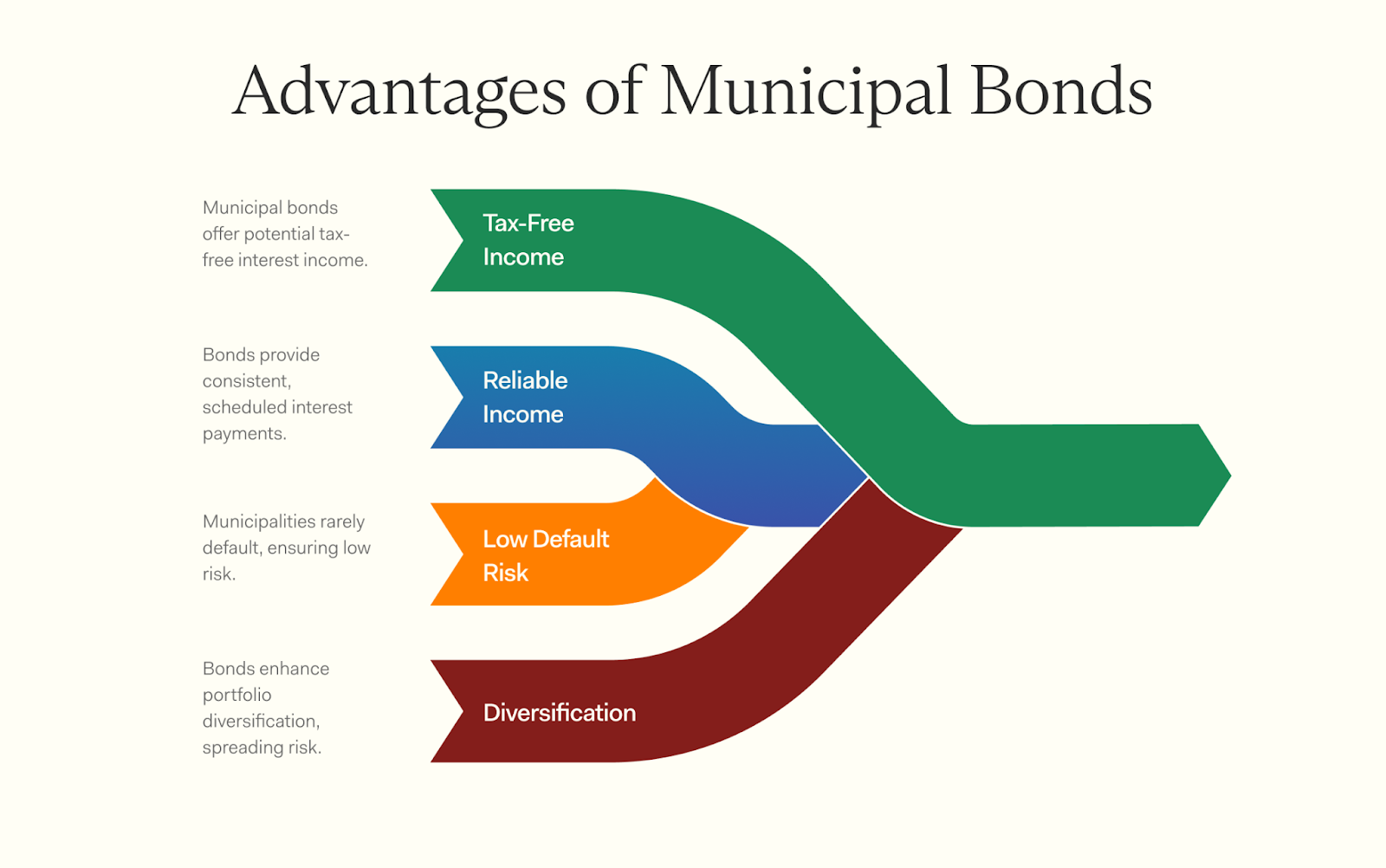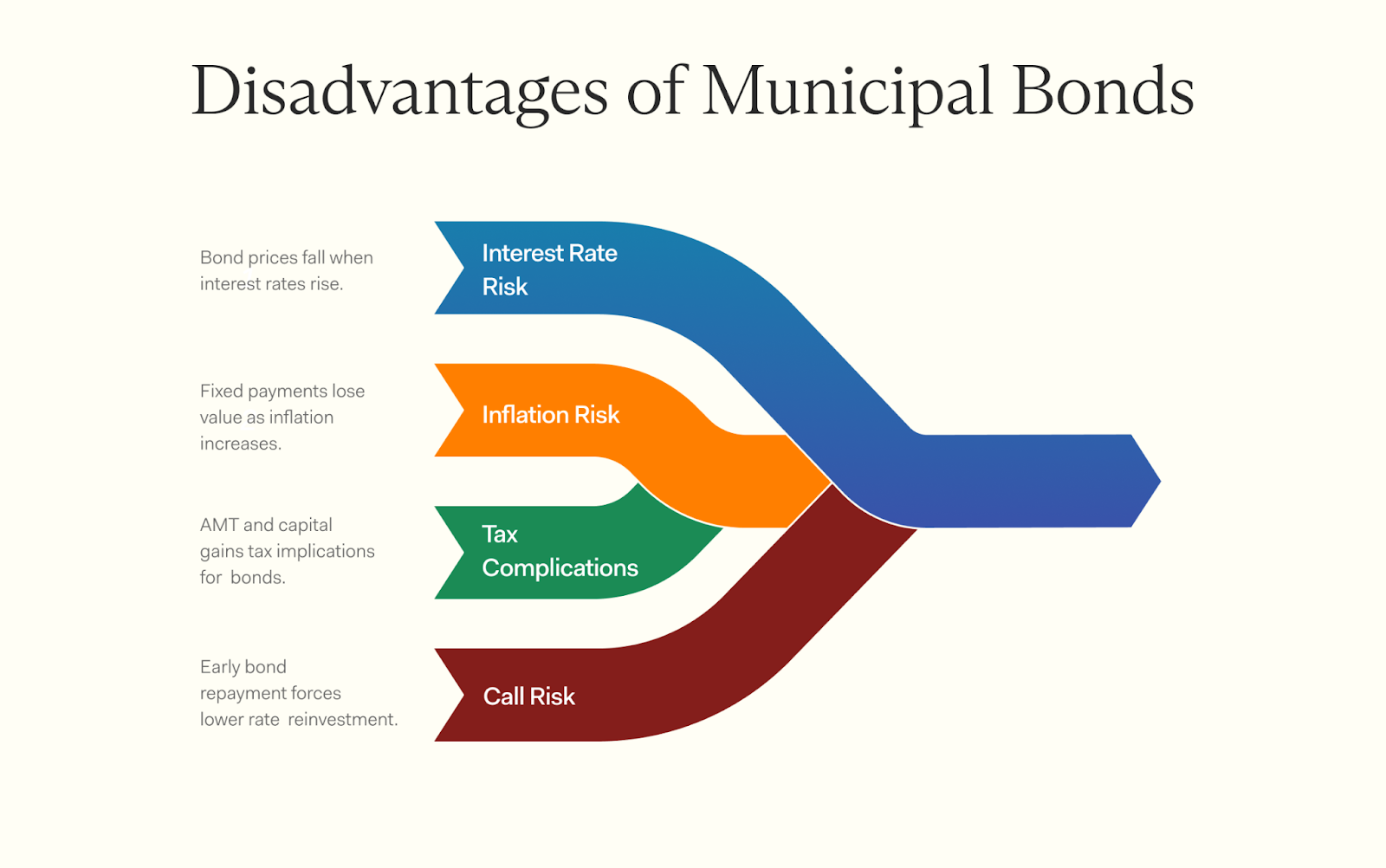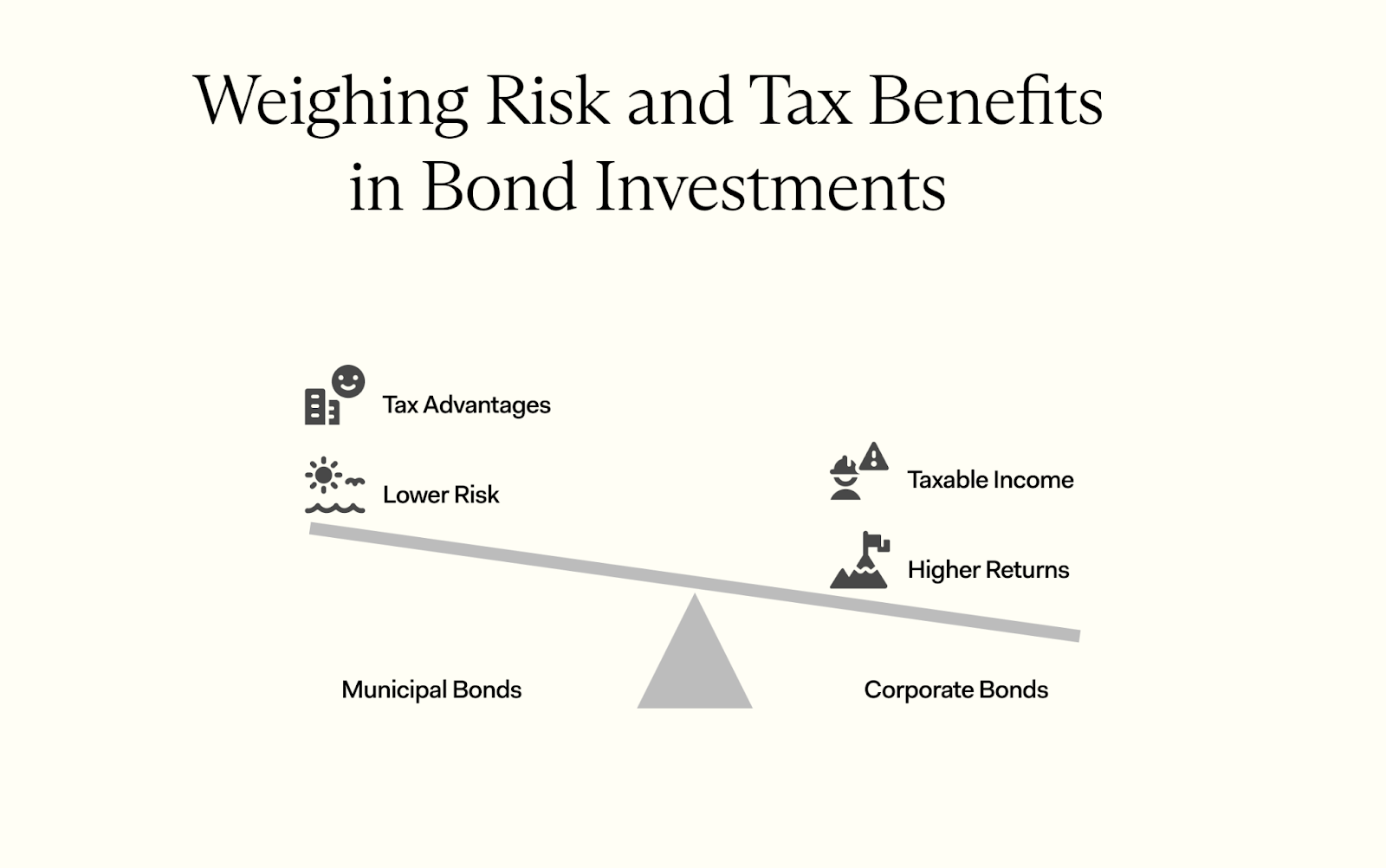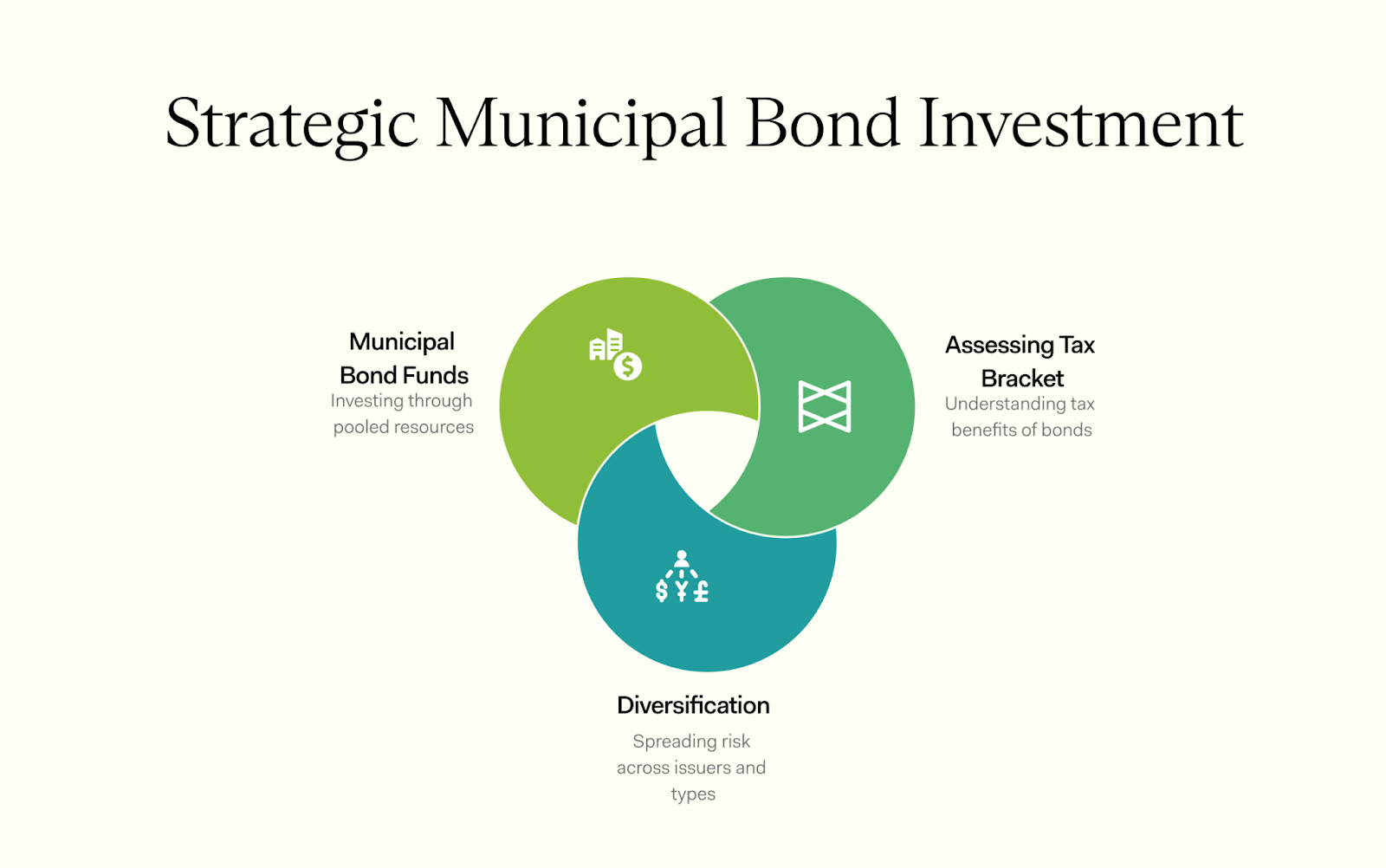Discover practical strategies to boost your municipal bond income while navigating potential risks. Read on for essential insights you can apply today.
How can you create reliable retirement income without unnecessary tax burden? Municipal bonds offer a compelling solution. These government-issued securities provide tax-free income at the federal level—and potentially at state and local levels too. This tax advantage can significantly boost your effective yield compared to taxable alternatives.
This guide examines municipal bonds' benefits and risks for retirement portfolios, helping you determine if their stable, tax-efficient income aligns with your retirement strategy.
Municipal bonds represent loans that investors provide to local governments, cities, or states. These governments use the funds for projects like schools, highways, and water systems. Investors are attracted to them because of the tax-free income these investments can generate.
Most municipal bonds fall into two categories: general obligation bonds and revenue bonds. General obligation bonds are backed by the government's power to tax. Revenue bonds pay back investors with money made from the project they fund.
Investing in municipal bonds means supporting community development while earning income free from federal taxes.
These investments are popular for being safe. The chance that a city or state will not pay back its bond is very low. This makes them a good choice for people who want steady income without much risk.

Municipal bonds offer a sweet combo of tax-free income and stability for retirees looking to relax without financial worry. They shine as low-risk, steady investments that keep the cash flowing when workdays are over.
One significant benefit of investing in municipal bonds is their tax-free income potential. Interest payments from many municipal bonds are not taxed at the federal level, meaning you keep more money in your pocket.
For those in higher tax brackets, this can be a substantial advantage.
Local tax policies, such as the state and local tax (SALT) deduction cap introduced by the Tax Cuts and Jobs Act (TCJA), can influence the attractiveness of municipal bonds, especially for investors in high-tax states.
Certain municipal bonds offer exemptions from state and local taxes as well. This feature makes them even more appealing for investors aiming to maximize their earnings. Tax-free status helps enhance total returns, especially for fixed income investments during retirement years.
It's like receiving payments without Uncle Sam taking a cut!
These tax-exempt bonds provide a reliable income stream for retirement. Investors receive interest payments regularly, typically twice a year. This creates a dependable cash flow you can count on year after year.
The payments come from the fees and taxes collected by municipal bond issuers, like states or cities.
Investors find comfort in knowing that many municipalities have low default risk. They tend to manage their debt well, making timely principal and interest payments. Because of this, municipal bonds can be great additions to your investment strategy for steady cash flow without the usual worries about credit risk associated with corporate bonds.
With their reliable income streams, municipal bonds also feature low default risk. This means these bonds are less likely to fail compared to other types of debt. Municipalities often have stable revenue sources, like taxes and fees, helping them pay their debts on time.
Investors can feel secure knowing that many municipalities carry strong credit ratings. High-quality fixed-income investments, such as investment-grade municipal bonds, tend to show a solid payment history.
In fact, defaults in the municipal bond market are rare. This makes them a safer choice for retirement income compared to higher-risk investments or taxable bonds.
Adding municipal bonds to your investment mix enhances portfolio diversification. This approach spreads your money across different types of investments, reducing overall risk. If one investment loses value, others may still perform well.
Tax-exempt municipal bonds can be a wise choice for retirement income. They offer tax benefits and provide steady interest income. Investors should consider combining these with other assets like stocks or corporate bonds to balance their returns and risks.
A diverse portfolio can help protect against market fluctuations while boosting growth potential.

Despite their benefits, municipal bonds have some downsides for retirement planning. Interest rates can rise, which may lower bond prices and affect the value of your investment.
Interest rate fluctuations pose a significant challenge for municipal bond investors. When interest rates climb, the prices of existing bonds typically fall. This decline affects the market value of your investment. For example, if you own a tax-exempt bond with a fixed rate and new bonds offer higher yields, yours becomes less appealing.
Investors may sell to avoid losses as rates increase, increasing supply and potentially contributing to lower prices, though demand can also be influenced by various other factors. This dynamic is crucial to understand when planning for retirement income with municipal bonds.
Balancing your investments can help manage this risk effectively.
The eroding effect of inflation can diminish money's value over time. While municipal bonds typically offer lower yields due to their tax-exempt status, it's important to consider these yields in the context of their tax benefits. If inflation rises, relatively low interest payments might not keep up with rising prices.
You may lose purchasing power with your bond income.
Those who rely heavily on municipal bonds for retirement could face challenges as costs increase. Rising prices can eat into the benefits of tax-free municipal bonds. Keeping an eye on inflation trends is key for investors seeking stable returns and protection against this risk.
Despite their tax advantages, municipal bonds aren't completely tax-free for everyone. High-income earners might face the alternative minimum tax (AMT) on earnings from private activity bonds, and taxes at the state and local levels might also apply.
Selling municipal bonds at a premium before maturity can result in capital gains, which are subject to different tax rules compared to the tax-exempt interest income from these bonds.
This means they could owe some taxes, even if the income is usually exempt.
Retirees should think about their entire tax situation before investing in tax-exempt municipal bonds. Understanding these potential tax implications helps investors make better choices for retirement income.
When bond issuers exercise early repayment options, investors face call risk. While this can happen during periods of lower interest rates as issuers seek to refinance at lower rates, it is not as frequent as it might seem. Not all municipal bonds come with call features. Some are callable while others are not. Investors should be aware of the features of bonds they hold. Tax-exempt municipal bonds can offer good returns, but call risk can cut into those gains—especially if you need steady income for retirement or want investment-grade options that stay reliable over time.
Beyond the primary risks, liquidity concerns deserve attention. Municipal bonds can be less liquid than other investments, potentially making it difficult to sell them quickly without affecting their market price.
Credit quality matters too. While municipal bonds generally maintain low default rates, they aren't risk-free. Financial challenges faced by issuers could lead to potential defaults, underscoring the importance of assessing credit quality before investing.
Municipal and corporate bonds differ in their risk-return profiles. Investors appreciate the tax advantages, as most income from municipal bonds is free from federal taxes. However, income from specific bonds like private activity bonds may be subject to the AMT. Also, the tax treatment can vary significantly at state and local levels.
To compare returns accurately, investors should calculate the tax-equivalent yield by taking the municipal bond's interest rate and dividing it by one minus the federal tax rate. This formula assumes the bond's income is fully exempt from federal taxes and doesn't account for potential AMT implications or state taxes.

Municipal bonds often have lower risk and tax advantages compared to corporate bonds, making them a popular choice for income-focused investors. Curious about how they stack up?
The risk-return profiles of municipal and corporate bonds show notable differences. Municipal bonds typically offer lower yields than their corporate counterparts, primarily due to their reduced risk profile.
Investors benefit from tax advantages, as the income from municipal bonds is generally exempt from federal taxes, although certain bonds such as private activity bonds may be subject to the Alternative Minimum Tax (AMT). Furthermore, state and local tax treatment can vary.
Corporate bonds may deliver higher returns but come with elevated risks. Companies facing financial difficulties might default on their obligations. Many conservative investors prefer high-quality fixed income options like investment grade municipal bonds instead of taking chances on higher-yielding corporate alternatives.
When choosing between these debt instruments, it's crucial to assess your personal risk tolerance.
To truly compare municipal and taxable bonds, investors need to understand tax-equivalent yield. This calculation reveals how municipal bond returns stack up against taxable alternatives after accounting for tax benefits.
To calculate the tax-equivalent yield, divide the municipal bond's interest rate by one minus your federal tax rate. For example, if you earn 3% on a municipal bond and face a 25% federal tax rate, your tax-equivalent yield is 4%. Note that this calculation assumes the municipal bond interest is completely exempt from federal taxes and does not account for potential state taxes or the AMT.
This means you'd need a 4% return from a taxable bond to match what you'd keep after taxes from the municipal bond. This comparison helps investors make informed choices between taxable investments and tax-exempt options like municipal bonds or funds containing them.
Beyond yield comparisons, municipal bond investors should evaluate liquidity factors. These bonds often trade less frequently than other securities, potentially making it challenging to sell them without affecting their price significantly. While municipal bonds generally maintain low default rates, credit risks exist as issuers could experience financial difficulties, potentially leading to defaults.
Before investing in municipal bonds for retirement, evaluate your tax situation carefully. Spread your risk by diversifying across different issuers and bond types. Consider municipal bond funds for a simplified approach to this investment class.

Your tax bracket plays a crucial role in municipal bond investing. Understanding your position helps determine how much you'll benefit from tax-exempt income. Municipal bonds provide interest that's exempt from federal taxes and sometimes state or local taxes as well.
Higher tax bracket investors typically gain more from these tax advantages. Those in lower brackets might find less value in municipal bonds compared to other investments.
Review your tax status thoroughly before committing significant funds to tax-exempt municipal bonds or other fixed-income options.
Spreading your municipal bond investments across different issuers and types represents smart risk management. Avoid concentrating your money in a single area. Select bonds from various government entities and categories to create balance.
Explore tax-exempt municipal bonds from different local governments, states, and agencies. Each issuer presents unique risk-reward characteristics. By distributing your investment, you can create a better balance between income potential and stability.
A municipal bond ladder can also help manage interest rate risk while providing consistent income over time.
For those seeking simplicity, municipal bond funds offer an accessible entry point to tax-exempt investments. These funds pool resources from multiple investors, allowing you to own a diversified portfolio of bonds through a single investment vehicle.
This approach provides access to high-quality fixed income without the complexity of selecting individual bonds.
Municipal bond funds can effectively support retirement planning by providing regular, tax-advantaged income streams. Many funds also support local infrastructure projects, creating community benefits alongside personal returns.
Look for options that align with your investment strategy and tax situation, carefully balancing potential returns against risks like interest rate fluctuations and market movements.
Municipal bonds can provide tax-free income, but they also come with risks like interest rate fluctuations and credit concerns. A Farther financial advisor can help you determine whether municipal bonds fit into your retirement income strategy and how to balance them with other investments.
Maximize your retirement income with the right approach. Talk to an advisor today to build a tax-efficient retirement plan.
Municipal bonds offer compelling advantages for retirement planning, from tax-free income to relative safety. However, they aren't without challenges—interest rate movements and inflation can impact their performance over time.
Consider your unique financial goals when evaluating these investments. Explore various bond options and fund structures to find what best complements your situation. With thoughtful planning, municipal bonds can contribute to a more secure retirement.
Keep learning about investment options as your situation evolves. Your retirement deserves careful consideration and informed decision-making.
Tax-exempt municipal bonds, also known as tax-free municipal bonds, are a type of investment where the interest paid is exempt from federal and often state and local income taxes.
Similar to other fixed-income investments such as treasury bonds, tax-free municipal bonds can appreciate in value when interest rates fall, although they are also subject to variations in market conditions and potential defaults.
Yes indeed! Investing in high-quality fixed-income assets like tax-exempt debt can provide steady investment income for your retirement. The tax benefits largely depend on your state of residence and the issuance location of the bonds, offering mostly federal tax exemption, and potentially state and local tax benefits if the bonds are issued in your state of residence.
While the benefits are appealing, it's important to consider potential downsides. For instance, when municipalities issue tax-exempt debt to finance infrastructure projects, risks such as interest rate changes, credit risks, and market volatility could affect bond prices and yields. Additionally, although rare, defaults can occur particularly in municipalities facing financial troubles.
Exchange-traded funds with a focus on tax-exempt securities provide investors an easy way into the market without needing to buy individual bonds. However, the tax benefits of these ETFs may vary based on the investor's state of residence and the specific bonds held within the ETF. It's advisable to consult with a tax professional or review the ETF's holdings to understand the specific tax implications. Municipal bond ETFs are typically designed by investment management firms to provide diversified exposure to these bonds.